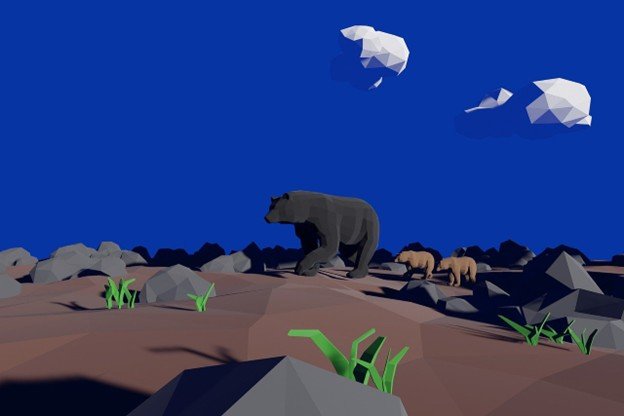AI has made headlines for composing music, writing scripts, and even designing buildings. But one area that’s quietly booming is 3D worldbuilding, especially in the indie space. The 3D modeling market is projected to hit USD13.32 billion by 2033, and AI will likely be at the center of that growth.
Want to bring your virtual vision to life as an indie creator? You no longer need massive teams or endless hours. With AI, generating low-poly assets and full 3D environments is faster and cheaper.
And since low-poly design continues to dominate indie games, mobile apps, and AR/VR platforms, this shift is huge. Let’s take a look at five tools that are changing how small teams and solo artists create 3D worlds.
What Is Low-Poly Design and Why It Matters
Low-poly design refers to 3D models created with a limited number of polygons. This approach keeps objects looking simple and stylized. It’s ideal for mobile games, indie titles, and virtual platforms where speed and style both matter.
One of the main advantages of low-poly is its efficiency. Fewer polygons mean faster rendering, lower hardware requirements, and easier customization. The best part? It does all that without sacrificing creativity.
This style is practical for indie developers working with small budgets or teams. It’s even more convenient with AI-driven tools like the low-poly generator.
Want to turn sketches or photos into 3D models in just a few clicks? Here are some of the tools you can try:
Tool #1: 3DAI Studio
3DAI is the go-to option for those who dread the steep learning curve of traditional software. This AI-powered platform transforms 2D images into detailed low-poly 3D assets. It’s ideal for quick prototyping or full-scale worldbuilding.
But what sets 3DAI Studio apart is its web-based interface. You don’t need to download anything or install complex plugins.
Simply upload your image, choose your preferred style, and let the AI do the work. The platform outputs clean, stylized models that are ready for game engines or further refinement.
It’s particularly useful for small teams or solo devs looking to cut down production time without sacrificing quality. And because it focuses specifically on low-poly generation, it’s a strong fit for mobile games, VR environments, and minimalist art projects.
Tool #2: Kaedim
Kaedim turns 2D images into usable 3D mesh models in just a few minutes. You upload a concept sketch, and their AI generates a textured model that’s game-ready. For indie creators without a background in 3D modeling, this is a huge shortcut.
What makes Kaedim stand out is its blend of speed and quality. It’s perfect for quickly prototyping characters, props, or environments without investing hours into modeling from scratch.
You still get control over edits, so the output doesn’t feel generic. It’s a smart way to keep momentum while building out your world.
Tool #3: RunwayML
RunwayML is a creative AI platform packed with tools for artists, including 3D generation. It’s not a full modeling suite, but it offers features like depth estimation, 3D object animation, and environment building, all powered by machine learning.
It’s ideal for experimenting with interactive content or testing ideas quickly. The interface is beginner-friendly, and many tools run right in your browser.
For indie devs exploring AR, VR, or interactive storytelling, RunwayML adds a lot of creative flexibility without needing deep technical skills. Plus, its capabilities make it a powerful tool for creating digital marketing content, like animated promos or interactive ads, that help indie creators showcase their projects.
Tool #4: Meshcapade
Meshcapade focuses on creating realistic 3D human avatars using AI. Just upload a few photos or scans, and it generates a fully rigged, animatable body model. It’s especially useful for indie games, fitness apps, or social VR projects.
You can also customize avatars for different body types, clothing, or movement. For creators who want high-quality characters without building from scratch, Meshcapade cuts down on development time while keeping the final product polished. It’s a practical solution when realism and speed both matter.
Tool #5: Blender with AI Plugins
You’ve definitely heard of Blender. It’s the oldest tool on this list, despite gaining traction post-2020.
Blender was already a go-to for indie 3D artists, but now AI plugins are making it even more powerful. Tools like BlenderGPT and AI Render bring machine learning into your modeling pipeline, helping you generate textures, animate rigs, or even auto-create assets.
These plugins are ideal for solo devs who want more output with less manual work. You still get Blender’s flexibility, but AI handles the tedious parts. It’s an open-source powerhouse made even better for modern indie workflows.
How Indie Creators Are Using These Tools
Indie creators are embracing these AI tools to bring their ideas to life without needing huge budgets or big teams. For example, a solo game developer could use 3DAI Studio to generate low-poly buildings, then plug those assets into Unity to prototype a full game world in days, not weeks.
Others use tools like Kaedim and Blender with AI plugins to rapidly design characters and props for VR training environments or AR experiences. Some leverage platforms like RunwayML to produce eye-catching marketing visuals as part of their content advertising strategies early in development.
Final Thoughts
AI-powered tools are opening new doors for indie developers. Whether it’s crafting stylized low-poly worlds or generating 3D characters on the fly, creators now have serious power at their fingertips.
Tools like 3DAI Studio make high-quality 3D worldbuilding more accessible than ever. But this new 3D wave isn’t just a convenience, it’s a shift in how games and virtual spaces are built.
